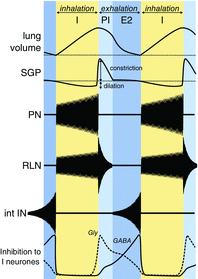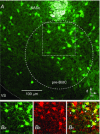Defining inhibitory neurone function in respiratory circuits: opportunities with optogenetics?
- PMID: 25384785
- PMCID: PMC4532524
- DOI: 10.1113/jphysiol.2014.280610
Defining inhibitory neurone function in respiratory circuits: opportunities with optogenetics?
Abstract
Pharmacological and mathematical modelling studies support the view that synaptic inhibition in mammalian brainstem respiratory circuits is essential for generating normal and stable breathing movements. GABAergic and glycinergic neurones are known components of these circuits but their precise functional roles have not been established, especially within key microcircuits of the respiratory pre-Bötzinger (pre-BötC) and Bötzinger (BötC) complexes involved in phasic control of respiratory pump and airway muscles. Here, we review briefly current concepts of relevant complexities of inhibitory synapses and the importance of synaptic inhibition in the operation of these microcircuits. We highlight results and limitations of classical pharmacological studies that have suggested critical functions of synaptic inhibition. We then explore the potential opportunities for optogenetic strategies that represent a promising new approach for interrogating function of inhibitory circuits, including a hypothetical wish list for optogenetic approaches to allow expedient application of this technology. We conclude that recent technical advances in optogenetics should provide a means to understand the role of functionally select and regionally confined subsets of inhibitory neurones in key respiratory circuits such as those in the pre-BötC and BötC.
© 2014 The Authors. The Journal of Physiology © 2014 The Physiological Society.
Figures




References
-
- Abdala APL, Liu BH, Rybak IA, Smith JC. Paton JFR. Role of GlyT2 expressing neurons in the Botzinger Complex for respiratory rhythm and pattern generation. FASEB J. 2010b;24:614.3. (Meeting Abstract Supplement)
-
- Abdala APL, Liu BHH, Rybak IA, Smith JC. Paton JFR. New lentiviral vector to selectively target glycinergic neurons in the brainstem. FASEB J. 2010c;24:614.2. (Meeting Abstract Supplement)
Publication types
MeSH terms
Grants and funding
LinkOut - more resources
Full Text Sources
Other Literature Sources

